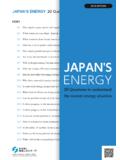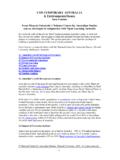Transcription of Sugar International Market Profile
1 Background paper for the Competitive Commercial Agriculture in Sub Saharan Africa (CCAA) Study Sugar International Market Profile Prepared by JenniferNyberg Markets and trade Division Food and Agriculture Organization of the United Nations Disclaimer: This background report is being made available to communicate the results of Bank-funded work to the development community with the least possible delay. The manuscript therefore has not been prepared in accordance with the procedures appropriate to formally edited texts.
2 Some sources cited in this report may be informal documents that are not readily available. The findings and interpretations expressed in this report are those of the author(s) and do not necessarily reflect the views of the Board of Executive Directors of the World Bank or the governments they represent, or those of the Food and Agriculture Organization of the United Nations (FAO). The World Bank and FAO do not guarantee the accuracy of the data included in this work. The designations employed and the presentation of the material in this work, including the boundaries, colors, denominations, and other information shown on any map do not imply any judgment on the part of the World Bank or FAO concerning the legal status of any territory or the endorsement or acceptance of such boundaries.
3 2 Sugar : International Market Profile 1 Introduction The International Sugar Market is one of the most highly distorted agricultural commodity markets. Raw and refined Sugar markets are generally characterized by significant and widespread domestic support and trade distorting policies, such as guaranteed minimum payments to producers, production and marketing controls (quotas), state-regulated retail prices, tariffs, import quotas and export subsidies. Although current world Sugar prices have largely retreated from the 25-year highs reached in February 2006, the Market remains particularly susceptible to large demand swings and price volatility.
4 Generally, International Sugar prices have generally trended downward as the production of traditional importing countries increased, largely due to domestic support measures. International trade is largely defined by preferential trade agreements in which Sugar -producing countries enjoy access to the higher priced domestic markets of the EU or USA through preferential access. trade under preferential agreements is very important to the Sugar sectors of many developing countries. Sugar trade between African Caribbean and Pacific countries (ACP) and the European Union, for example, is regulated by two agreements: the ACP/EU Sugar Protocol and the Agreement on Special Preferential Sugar (SPS).
5 Other significant trade agreements in International Sugar markets include the Everything But Arms (EBA) initiative, Caribbean Basin Initiative (CBI), African Growth and Opportunity Act (USA), North American Free trade Agreement (NAFTA), and the Southern Africa Customs Union (SACU). FAO studies have found that EU Sugar policy reform implies an erosion of preferences for the ACP countries that export to the EU under the Sugar Protocol, with potential gains for LDCs due to the implementation of the EBA initiative, primarily over the medium to longer term. Sugarcane offers production alternatives to food, such as feed, fibre and energy, particularly biofuels ( Sugar -based ethanol) and/or co-generation of electricity.
6 Sugarcane is generally regarded as one of the most significant and efficient sources of biomass for biofuel production, and given expectations of rising oil prices, the considerable potential for expansions in production for biofuel feedstock has resulted in a heightened focus on Sugar as an internationally traded commodity. Strong linkages between world Sugar and oil prices have emerged in recent years, driven in part by the relationships between Sugar as the primary ethanol feedstock in Brazil, the most dominant producer and exporter of both Sugar and ethanol in the world.
7 A wide range of environmental and social issues are connected with sugarcane production and processing, and sugarcane growers, processors, plus energy and food companies, are seeking ways to address concerns related to Sugar production, biofuels and Continued 1 Se e draft ToR, IFC Technical Assistance P roject, on the Preparation of Guidance Docum ent on Good M anagement Practices for Sugarcane, based on the a multi-stakeho lder Better Sugar cane Initiativ e ( BSI) created in June 20 0 5 to capture the int er ests of a wid e r ange of stakehol der s in the sugarcane sector including trader s, investors, sell ers of br anded Sugar -containing products, banks, researchers, env ironmental and socia l conc er ns of civi l society, an d sugarcane gr owing interests fr om ma jor world growing ar eas.
8 The BSI approach is to dev elop inter national ly-appli cab le guidel ines to d efin e a sustainable approach to growing and processing sugarcane. The init iative compl ements the IF C Biodiver sity and Agricultural Commoditi e s P rogram (BACP), funded by the Globa l Envir onment Fund (GEF) , aimed at reducing habitat destruction by lev er aging Market forces at al l levels of the va lue ch ain in order 3 domestic support measures, highly regulated trade and uncertain future policy scenarios (continued price supports for Sugar production or preferential trade agreements) may have constrained opportunities for capital investment in biofuels and other renewable energy sources.
9 For countries with the need to diversify or modernize cane sectors to focus on feedstock potential, new forms of public and private cooperation and partnership are necessary. 2 Market Structure Production More than 130 countries produce either sugarcane or sugarbeet, and ten of these produce Sugar from both cane and beet Sugarcane, on average, accounts for 75 to 80 percent of global production per year, and developing countries produce about 70 percent of total global output. Production has become increasingly concentrated since 1980, when the top ten producing countries accounted for 56 percent of global output compared to 2004, when the top ten accounted for 69 Table 1 - Top 10 Producing and Consuming Countries in 2005 (million metric tons, raw equivalent)
10 Production Consumption 1 Brazil 1 India 2 EU 2 EU 3 India 3 China 4 China 4 Brazil 5 USA 5 USA 6 Mexico 6 Russian Fed 7 Australia 7 Mexico 8 Thailand 8 Pakistan 9 Pakistan 9 Indonesia 10 Russian Fed 10 Egypt Total Total World Total World Total Percent 73% Percent 64% Source: ISO Sugar Yearbook 2005 The largest Sugar producing countries in the world consist of both beet and cane Sugar producers, which combined account for more than 70 percent of global output (see Table 1). Brazil, Australia and Thailand, included amongst the list of the top ten Sugar producing countries from sugarcane, are also considered amongst the lowest cost and efficient of global Sugar producers.













